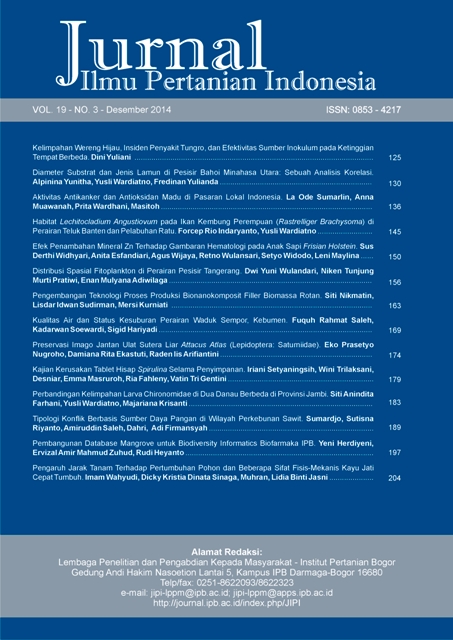Perbandingan Kelimpahan Larva Chironomidae di Dua Danau Berbeda di Provinsi Jambi
Abstract
This research was conducted at two different lakes in Jambi Province (Lake Sipin and Lake Teluk) to compare abundance of aquatic insect larvae (family: Chironomidae). Lake Sipin located close by the settlement and got many influences from anthropogenic activities. However, Lake Teluk got less anthropogenic disturbance. Both lakes have difference plants cover. The area around Lake Sipin was more open compared to Lake Teluk and it caused low transparency level in Lake Sipin. The transparency level of Lake Sipin was 58.62 cm whereas transparency level of Lake Teluk was 70.29 cm. The difference of this transparency level influenced Chironomidae Larvae abundance that was encountered. Larvae abundance which was found in Lake Sipin was 49 ind/m2, while larvae abundance of Lake Teluk was 374 ind/m2. The result showed that water transparency level, water colors and vegetation affected abundance of Chironomidae larvae.
Downloads
References
Arimoro FO, Ikomi RB, Iwegbue CMA. 2007. Water quality changes in relation to diptera community patterns and diversity measured at an organic effluent ampacted stream in the Niger Delta, Nigeria. Ecological Indicators. 7(3): 541-552.
Armitage PD, Cranston PS, Pinder LCV. 1995. The Chironomidae: The Biology and Ecology of Non-Biting Midges. Chapman & Hall, London (GB).
Bay EC. 2003. Chironomida Midges. Washington State University (US).
Biasi C, Tonin AM, Restello RM, Hepp LU. 2013. The colonisation of leaf litter by Chironomidae (Diptera): the influence of chemical quality and exposure duration in a subtropical stream. Elsevier. Limnologica. 43(6): 427-433.
Carew ME, Pettigrove V, Hoffmann AA. 2003. Identifying Chironomidas (Diptera: Chironomidae) for Biological Monitoring with PCR-RFLP. Bulletin of Entomological Research. Australia.
Canedo-Arguelles M, Rieradevall M. 2011. Early succession of the macroinvertebrate community in a shallow lake: response to changes in the habitat condition. Limnologica Ecology and Management of Inland Waters. 41(4): 363-370.
Delettre YR. 2000. Larvae of terrestrial Chironomidae (Diptera colonize the vegetation layer during the rainy season. Pedobiologia. 44(5): 622-626.
Epler JH. 2001. Identification manual for the larval Chironomidae (Diptera) of north and south Carolina. North Carolina Department of environment and natural resources. Division of Water Quality. Crawfordville (US).
Farhani SA. 2012. Perkembangan dan pertumbuhan larva Chironomus sp pada level bahan organik berbeda dalam skala laboraorium [Skripsi]. Bogor (ID): Institut Pertanian Bogor.
Frouz J. 1997. The effect of vegetation patterns on oviposition habitat preference: a driving mechanism in terrestrial chironomid (Diptera: Chironomidae) succession?. Researches Population Ecology. 39(20): 207-213.
Halpern M, Gasith A, Broza M. 2002. Does the tube of a benthic chironomida larva play a role in protecting its dweller against chemical toxicants?. Departement of Biology, University of Haifa (IL).
Halpern M, Raats D, Lavion R, Mittler S. 2006. Dependent population dynamics between chironomids (nonbiting midges) and Vibrio cholerae. FEMS Microbiol Ecology. 55(1): 98-104.
Heinrich ML, Barnekov L, Rosenberg S. 2006. A comparison of chironomid biostratigraphy from Lake Vuolep Njakajaure with vegetation, lake-level, and climate changes in Abisko National Park, Sweden. Journal of Paleolimnology. 36(2): 119-131.
Junshum P, Choonluchanon S, Traichaiyaporn S. 2008. Bbiological indices for classification of water quality around Mae Moh power plant, Thailand. Maejo International Journal of Science and Technology. 2(1): 24-36.
Lerner A, Meltser N, Sapir N, Erlick C, Shashar N, Broza M. 2008. Reflected polarization giudes chironomid females to oviposition sites. Journal of Experimental Biology. 211(22): 3536-3543.
Meier PG, Choi K, Sweet LI. 2000. Acute and chronic life cycle toxicity of acenaphthene and 2, 4, 6 trichlorophenol to the midge Paratanytarsus parthenogeneticus (Diptera: Chironomidae). Aquatic Toxicology. 51(1): 31-44.
Meltser N, Kashi Y, Broza M. 2008. Does polarized light guide chironomids to navigate toward water surfaces?. Boletin do Museu Municipal do Funchal (História Natural). 13: 141-149.
Odume ON, Muller WJ. 2011. Diversity and structure of Chironomidae communities in relation too water quality differences in the Swartkops River. Elsevier. Aquaculture. 36: 929-938.
Pinder LCV. 1986. Biology of freshwater Chironomidae. Annual Review of Entomology. 31: 1-23.
Simon FX, Penru Y, Guastalli AR, Llorens J, Baig S. 2011. Improvement of the analysis of the biochemical oxygen demand (BOD) of Mediterranean seawater by seeding control. Elsevier. Talanta. 85 (1): 527-532.
Sutapa IDA. Kajian jar-test koagulasi-flokulasi sebagai dasar perancangan instalasi pengolahan air gambut menjadi air bersih. http://www.opi.lipi.go.id/ data/1228964432/data/13086710321320146107. makalah.pdf. 28 Oktober 2014.
Wardiatno Y, Krisanti M. 2013. The vertical dynamics of larval chironomids on artificial substrates in Lake Lido (Bogor, Indonesia). Tropical Sciences Research. 24(2): 13-29.
Zilli FL. Montalto L, Paggi A, Merchese C. 2008. Biometry and life cycle of chironomus calligraphus Goeldi 1905 (Diptera, Chironomidae) in laboratory conditions. Association Interciencia. 33(10): 767-770.
Zuazo VH, Pleguezuelo CR, Peinando FJ, Graaff JD, Martinez JR, Planagan DC. 2011. Environmental impact of introducing plant covers in the taluses of terraces: implication for mitigating agricultural soil erosion and runoff. Elsevier. Catena. 84(1-2): 79-88.
This journal is published under the terms of the Creative Commons Attribution-NonCommercial 4.0 International License. Authors who publish with this journal agree to the following terms: Authors retain copyright and grant the journal right of first publication with the work simultaneously licensed under a Creative Commons Attribution-NonCommercial 4.0 International License. Attribution — You must give appropriate credit, provide a link to the license, and indicate if changes were made. You may do so in any reasonable manner, but not in any way that suggests the licensor endorses you or your use. NonCommercial — You may not use the material for commercial purposes.



















